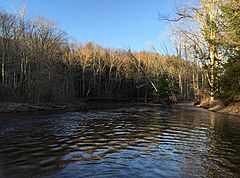Salmon River (Connecticut) facts for kids
Quick facts for kids Salmon River |
|
|---|---|

Looking downstream on the Salmon River immediately after the confluence of the Jeremy and Blackledge Rivers.
|
|
| Country | United States |
| State | Connecticut |
| Cities | Colchester, East Hampton, East Haddam, Haddam |
| Physical characteristics | |
| River mouth | confluence with Connecticut River East Haddam & Haddam, Middlesex County |
| Length | 10.4 mi (16.7 km) |
| Basin features | |
| Basin size | 150 sq mi (390 km2) |
| Tributaries |
|
The Salmon River is a beautiful river in Connecticut, United States. It starts where two other rivers, the Blackledge River and the Jeremy River, meet. This spot is near North Westchester, Connecticut. The river flows for about 10.4 miles (16.7 km) into Salmon Cove, near Moodus, Connecticut. From there, its water joins the big Connecticut River.
The Salmon River is special because its entire journey, from where it begins to where it ends, stays within Connecticut. It also has a large watershed, which is the area of land that drains water into the river.
Contents
Fun on the Salmon River
The Salmon River is a popular spot for outdoor activities.
Paddling Adventures
If you like to paddle, the Salmon River offers a great route. You can go kayaking or canoeing along about 7 miles of the river. The difficulty changes along the way:
- Some parts are "quickwater," meaning the water moves pretty fast.
- Other parts have "Class II whitewater," which means there are some small rapids and waves. It's a fun challenge for paddlers!
The paddling route starts near River Road, just a short distance from where the river forms. It ends in the calmer waters of Salmon Cove.
River Power in the Past
Long ago, in the 1800s and early 1900s, the Salmon River was very important for local businesses. The river drops quite a bit in height over its course. This drop created strong water power. This power was used to run textile mills in the town of Moodus. These mills made fabric and other goods.
Protecting the Salmon River
Since the early 1900s, many people and groups have worked hard to protect the Salmon River and the land around it. This effort includes federal, state, and local organizations.
Silvio O. Conte National Wildlife Refuge
A special part of the Silvio O. Conte National Fish and Wildlife Refuge is dedicated to the Salmon River. This area covers 425 acres near where the Salmon River meets the Connecticut River. It protects many different natural habitats, including:
- Freshwater marshes with tides.
- Grassy areas along the river.
- Cool, clear streams that flow into the river.
- Forests that grow on floodplains.
- Mixed hardwood forests and hemlock trees.
- Vernal pools, which are temporary ponds important for amphibians.
State Parks and Forests
Connecticut has also set aside large areas to protect the Salmon River watershed:
- The Salmon River State Forest was created in 1934. It has grown to about 6,000 acres across several towns like Hebron, Marlborough, Colchester, East Haddam, and East Hampton.
- Machimoodus State Park in East Haddam is 300 acres.
- Day Pond State Park in Colchester is 180 acres.
- Wopowaug Wildlife Management Area in East Hampton and Haddam is 465 acres.
These state-owned lands help keep the natural habitats and rural feel of the Salmon River area safe.
Local Conservation Efforts
Many local Land trusts also help protect the Salmon River basin. These groups own smaller nature preserves and conservation easements. An easement means they protect the land from development, even if it's still privately owned. Some examples include:
- Pine Brook Preserve in Haddam.
- Keech Preserve and Salmon Cove Preserve in East Haddam.
- The Gateway Property and Palakewitz Easement in Colchester.
These efforts ensure that the Salmon River and its surrounding natural beauty will be preserved for future generations to enjoy.

